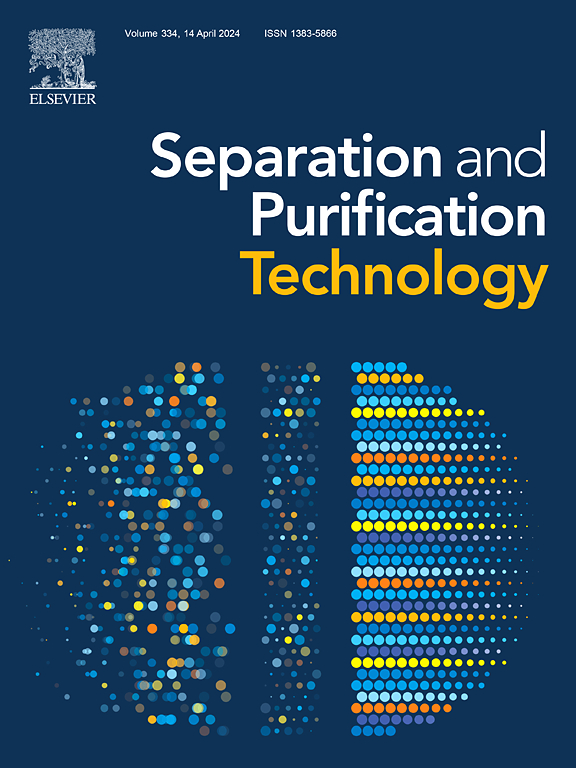Prediction of parameters and simulation of the process for boron isotope separation
IF 8.1
1区 工程技术
Q1 ENGINEERING, CHEMICAL
引用次数: 0
Abstract
High − abundance boron isotopes are “bottleneck − restricting” products in fields such as the nuclear industry, nuclear medicine and semiconductor manufacturing. Chemical exchange distillation with anisole as complexing agent is a promising boron isotope separation technology. Due to the lack of key physical properties of boron isotopes and their corresponding complexes, there was not a rigorous separation process model reported in literature. The complex conformation and enthalpy change was investigated with Density Functional Theory (DFT) based on the MP2/6-311++G(d,p) group using solvation effect. The Henry’s coefficients of BF3 in anisole and complexes were predicted using the COSMO-RS model, the values were 0.2847 (10BF3), 0.2847 (11BF3) and 2.2909 (10BF3), 2.2910 (11BF3) respectively, indicating that boron trifluoride was mainly dissolved in anisole rather than in complexes. The equilibrium constants of exchange reaction in anisole at various temperature were necessary and obtained by analyzing the resonant frequency. Then a rigorous model of the chemical exchange distillation process insisting of exchange column, complexation reactor, and cracking reactor was established. The appropriate operating conditions are as follows: the temperature of the complexation reactor is 25 ℃, the temperature of the low − temperature cracking reactor is 110 ℃, and the temperature of the high − temperature cracking reactor is 170 ℃. Under the appropriate operating conditions, the specific heating energy consumption for producing 10BF3 products with abundances of 85 %, 95 %, and 99 % is 6.90 × 105 kJ/t, 7.41 × 105 kJ/t, and 1.42 × 106 kJ/t respectively, and the yields are 71.76 %, 65.27 %, and 56.32 % respectively. Furthermore, a vacuum deep − cracking method was proposed to obtain 11BF3 with an abundance of 99.9 %, which overcame the back-mixing caused by the reused anisole.


高丰度硼同位素是核工业、核医学和半导体制造等领域的 "瓶颈限制 "产品。使用苯甲醚作为络合剂进行化学交换蒸馏是一种很有前途的硼同位素分离技术。由于缺乏硼同位素及其相应络合物的关键物理性质,文献中没有严格的分离过程模型。基于 MP2/6-311++G(d,p)组的密度泛函理论(DFT)利用溶解效应研究了络合物的构象和焓变。利用 COSMO-RS 模型预测了苯甲醚和络合物中 BF3 的亨利系数,其值分别为 0.2847(10BF3)、0.2847(11BF3)和 2.2909(10BF3)、2.2910(11BF3),表明三氟化硼主要溶解在苯甲醚中而不是络合物中。通过分析共振频率,得出了在不同温度下苯甲醚中交换反应的平衡常数。然后建立了化学交换蒸馏过程的严谨模型,包括交换塔、络合反应器和裂解反应器。合适的操作条件如下:络合反应器的温度为 25 ℃,低温裂解反应器的温度为 110 ℃,高温裂解反应器的温度为 170 ℃。在适当的操作条件下,生产丰度为 85%、95% 和 99% 的 10BF3 产品的特定加热能耗分别为 6.90 × 105 kJ/t、7.41 × 105 kJ/t 和 1.42 × 106 kJ/t,产量分别为 71.76%、65.27% 和 56.32%。此外,还提出了一种真空深度裂解方法,以获得丰度为 99.9 % 的 11BF3,该方法克服了重复使用的苯甲醚引起的回混现象。
本文章由计算机程序翻译,如有差异,请以英文原文为准。
求助全文
约1分钟内获得全文
求助全文
来源期刊

Separation and Purification Technology
工程技术-工程:化工
CiteScore
14.00
自引率
12.80%
发文量
2347
审稿时长
43 days
期刊介绍:
Separation and Purification Technology is a premier journal committed to sharing innovative methods for separation and purification in chemical and environmental engineering, encompassing both homogeneous solutions and heterogeneous mixtures. Our scope includes the separation and/or purification of liquids, vapors, and gases, as well as carbon capture and separation techniques. However, it's important to note that methods solely intended for analytical purposes are not within the scope of the journal. Additionally, disciplines such as soil science, polymer science, and metallurgy fall outside the purview of Separation and Purification Technology. Join us in advancing the field of separation and purification methods for sustainable solutions in chemical and environmental engineering.
 求助内容:
求助内容: 应助结果提醒方式:
应助结果提醒方式:


